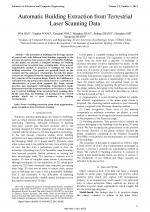| 3/2013 - 2 |
Automatic Building Extraction from Terrestrial Laser Scanning DataHAO, W. |
| Extra paper information in |
| Click to see author's profile in |
| Download PDF |
Author keywords
building extraction, point cloud segmentation, plane recognition, terrestrial laser scanning
References keywords
data(13), sensing(9), remote(9), photogrammetry(8), segmentation(6), laser(6), extraction(6), ransac(5), point(5), building(5)
Blue keywords are present in both the references section and the paper title.
About this article
Date of Publication: 2013-08-31
Volume 13, Issue 3, Year 2013, On page(s): 11 - 16
ISSN: 1582-7445, e-ISSN: 1844-7600
Digital Object Identifier: 10.4316/AECE.2013.03002
Web of Science Accession Number: 000326321600002
SCOPUS ID: 84884962911
Abstract
The extraction of building from the huge amount of point clouds with different local densities, especially in the presence of random noisy points, is still a formidable challenge. In this paper, we present a complete strategy for building extraction from terrestrial laser scanning data. First, a novel segmentation method is proposed to facilitate the task of building extraction. The points are grouped based on the normals and the adjacency relationships. Second, the planar surfaces are recognized from the segmentation results based on the properties of the Gaussian image. Finally, the buildings are extracted from the urban point clouds based on a collection of characteristics of point cloud segments like shape, normal direction and topological relationship. Experimental results demonstrate that the proposed method can be used as a robust way to extract buildings from terrestrial laser scanning data. At the same time, the buildings are decomposed into several patches which lay a good foundation for building reconstruction. |
| References | | | Cited By |
Web of Science® Times Cited: 11 [View]
View record in Web of Science® [View]
View Related Records® [View]
Updated 2 days, 6 hours ago
SCOPUS® Times Cited: 13
View record in SCOPUS® [Free preview]
View citations in SCOPUS® [Free preview]
[1] PointNAC: Copula-Based Point Cloud Semantic Segmentation Network, Deng, Chunyuan, Chen, Ruixing, Tang, Wuyang, Chu, Hexuan, Xu, Gang, Cui, Yue, Peng, Zhenyun, Symmetry, ISSN 2073-8994, Issue 11, Volume 15, 2023.
Digital Object Identifier: 10.3390/sym15112021 [CrossRef]
[2] A Novel Keep Zero as Zero Polar Correlation Technique for Mobile Robot Localization using LIDAR, SIDHARTHAN, R. K., KANNAN, R., SRINIVASAN, S., BALAS, M. M., Advances in Electrical and Computer Engineering, ISSN 1582-7445, Issue 4, Volume 16, 2016.
Digital Object Identifier: 10.4316/AECE.2016.04003 [CrossRef] [Full text]
[3] A multi‐scale plane‐detection method based on the Hough transform and region growing, Leng, Xiaoxu, Xiao, Jun, Wang, Ying, The Photogrammetric Record, ISSN 0031-868X, Issue 154, Volume 31, 2016.
Digital Object Identifier: 10.1111/phor.12145 [CrossRef]
[4] A Window Detection Algorithm for Remote Laser Gas Leakage Detection System, Dong, Xiaozhou, Li, Jiaying, Wu, Junxian, Liu, Juan, Procedia Computer Science, ISSN 1877-0509, Issue , 2020.
Digital Object Identifier: 10.1016/j.procs.2020.06.148 [CrossRef]
[5] Slice-Based Window Detection from Scene Point Clouds, Hao, Wen, Wang, Yinghui, Liang, Wei, Ning, Xiaojuan, Li, Ye, 2018 International Conference on Virtual Reality and Visualization (ICVRV), ISBN 978-1-5386-8497-9, 2018.
Digital Object Identifier: 10.1109/ICVRV.2018.00014 [CrossRef]
[6] Extraction of lattice openings of buildings from terrestrial LiDAR data, Susaki, Junichi, 2014 8th IAPR Workshop on Pattern Reconition in Remote Sensing, ISBN 978-1-4799-7276-0, 2014.
Digital Object Identifier: 10.1109/PRRS.2014.6914285 [CrossRef]
Disclaimer: All information displayed above was retrieved by using remote connections to respective databases. For the best user experience, we update all data by using background processes, and use caches in order to reduce the load on the servers we retrieve the information from. As we have no control on the availability of the database servers and sometimes the Internet connectivity may be affected, we do not guarantee the information is correct or complete. For the most accurate data, please always consult the database sites directly. Some external links require authentication or an institutional subscription.
Web of Science® is a registered trademark of Clarivate Analytics, Scopus® is a registered trademark of Elsevier B.V., other product names, company names, brand names, trademarks and logos are the property of their respective owners.
Faculty of Electrical Engineering and Computer Science
Stefan cel Mare University of Suceava, Romania
All rights reserved: Advances in Electrical and Computer Engineering is a registered trademark of the Stefan cel Mare University of Suceava. No part of this publication may be reproduced, stored in a retrieval system, photocopied, recorded or archived, without the written permission from the Editor. When authors submit their papers for publication, they agree that the copyright for their article be transferred to the Faculty of Electrical Engineering and Computer Science, Stefan cel Mare University of Suceava, Romania, if and only if the articles are accepted for publication. The copyright covers the exclusive rights to reproduce and distribute the article, including reprints and translations.
Permission for other use: The copyright owner's consent does not extend to copying for general distribution, for promotion, for creating new works, or for resale. Specific written permission must be obtained from the Editor for such copying. Direct linking to files hosted on this website is strictly prohibited.
Disclaimer: Whilst every effort is made by the publishers and editorial board to see that no inaccurate or misleading data, opinions or statements appear in this journal, they wish to make it clear that all information and opinions formulated in the articles, as well as linguistic accuracy, are the sole responsibility of the author.





